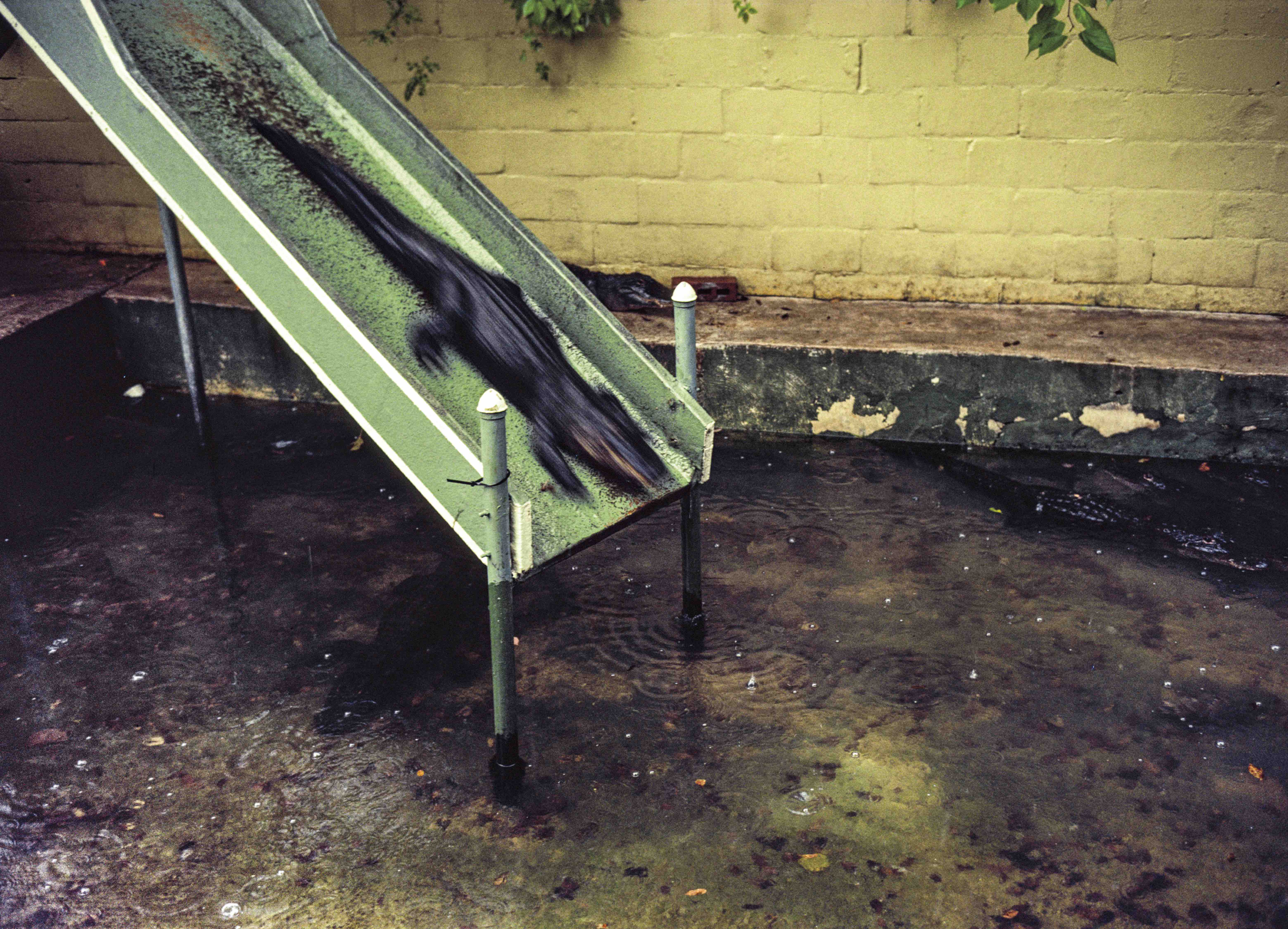Documenting the dark side of ’80s Florida
- Text by Miss Rosen
- Photography by Nathan Benn

The image of Florida is a curious mélange of palm trees and sandy beaches, gators and golfers on the green, and something darker lying in wait, ready to take the bait — best known to in the headlines as “Florida Man.” Peel back the cheerful veneer of “the happiest place on earth,” and what you find is something far more unusual.
Perhaps it is the draw of living in the Sunshine State that has cast Florida as the dream destination for people living across the Americas. “Whether they were snowbirds moving from the north into retirement or whether they were refugees, economic or political, from the Caribbean, Florida has always had this allure as a place of opportunity,” says Florida native Nathan Benn, who is showing photographs from his new book A Peculiar Paradise (powerHouse) at HistoryMiami Museum this winter.

Krome Detention Center, West Miami

Haitian refugees attempt to immigrate, Biscayne Bay, Miami.
“This is not like any other celebration of the state: other Florida picture books have sunsets, palm trees and beaches, and pink stucco,” Benn adds. Here, we have everything from Dundee’s 5th Street Gym, where Muhammad Ali famously trained, to Benn’s work with Frank White (a.k.a. “Dirty Harry”) at the Drug Enforcement Agency during the early days of the Drug War.
Drawing from an archive of more than 27,000 photographs taken of his home state while photographing for National Geographic Magazine over a period of 20 years, A Peculiar Paradise is a love letter to a most unusual land.
“When I was growing up in the ’50s and ‘60s, Miami was considered very different from the rest of the state but it really wasn’t,” the photographer remembers. “Miami was a white town. In 1950, the year I was born, it was 84 per cent Anglo-white, 16 per cent Black, and 0 per cent Latinx. Today, South Florida, two-thirds of the population is Latinx.”

Bal des Arts gala, Breakers Hotel, Palm Beach.

Humberto Alvarcado teaches guerilla tactics at Alpha 66 training camp, dedicated to overthrow the Castro regime and return to Free Cuba, Homestead, 1981
“When I was 18 year old, I started interning at the Miami News, and I learned a lot. But I also knew that Florida was in a very provincial place and I wanted to get out as fast as I could. As soon as I picked up my diploma from the University of Miami in 1972, I headed to Washington. I graduated on a Monday night and started work on Wednesday morning for National Geographic.”
But the move couldn’t keep Benn away. In 1981, he embarked on a year-long assignment to document Florida for the Geographic, creating a complex, nuanced, and multi-faceted view of the state from the eyes of one who knows it well.
In Benn’s Florida, we delve into the deeper stories of the people who call the state home. We witness the arrival of Cuban immigrants and the refugee boats coming in from Haiti, and the enduring xenophobia from Caucasians who embodied the ethos of the Confederacy, more than a century after it fell. We see the radical polarisation between Left and Right, an ongoing reminder that the seeds of nation’s current political climate were planted a very long time ago.

Sugar cane cutters from Jamaica prepare to go home after harvest season, Miami International Airport

Visitor parking at Kennedy Space Center, Cape Canaveral.

Gatorland, St. Augustine

Gatorland, St. Augustine.

Fountainbleau Hotel, Miami Beach

Sully Emmett collected the gym’s membership dues. 5th Street Gym, Miami Beach, 1981.

Spraying mosquito control insecticide from DC-3s, Collier County.
A Peculiar Paradise: Florida Photographs by Nathan Benn is on view at HistoryMiami Museum through April 14, 2019.
Follow Miss Rosen on Twitter.
Enjoyed this article? Like Huck on Facebook or follow us on Twitter.
You might like

Largest-Ever Display of UK AIDS Memorial Quilt Opens at Tate Modern
Grief Made Visible — Comprising hundreds of panels made by lovers, friends and chosen family, the UK AIDS Memorial Quilt returns in full for the first time since 1994 – a testament to grief, friendship and the ongoing fight against HIV stigma.
Written by: Ella Glossop

In Medellín’s alleys and side streets, football’s founding spirit shines
Street Spirit — Granted two weeks of unfettered access, photographer Tom Ringsby captures the warmth and DIY essence of the Colombian city’s grassroots street football scene.
Written by: Isaac Muk

Remembering New York’s ’90s gay scene via its vibrant nightclub flyers
Getting In — After coming out in his 20s, David Kennerley became a fixture on the city’s queer scene, while pocketing invites that he picked up along the way. His latest book dives into his rich archive.
Written by: Miss Rosen

On Alexander Skarsgård’s trousers, The Rehearsal, and the importance of weirdos
Freaks and Finances — In the May edition of our monthly culture newsletter, columnist Emma Garland reflects on the Swedish actor’s Cannes look, Nathan Fielder’s wild ambition, and Jafaican.
Written by: Emma Garland

New documentary revisits the radical history of UK free rave culture
Free Party: A Folk History — Directed by Aaron Trinder, it features first-hand stories from key crews including DiY, Spiral Tribe, Bedlam and Circus Warp, with public streaming available from May 30.
Written by: Isaac Muk

We are all Mia Khalifa
How humour, therapy and community help Huck's latest cover star control her narrative.
Written by: Alya Mooro

